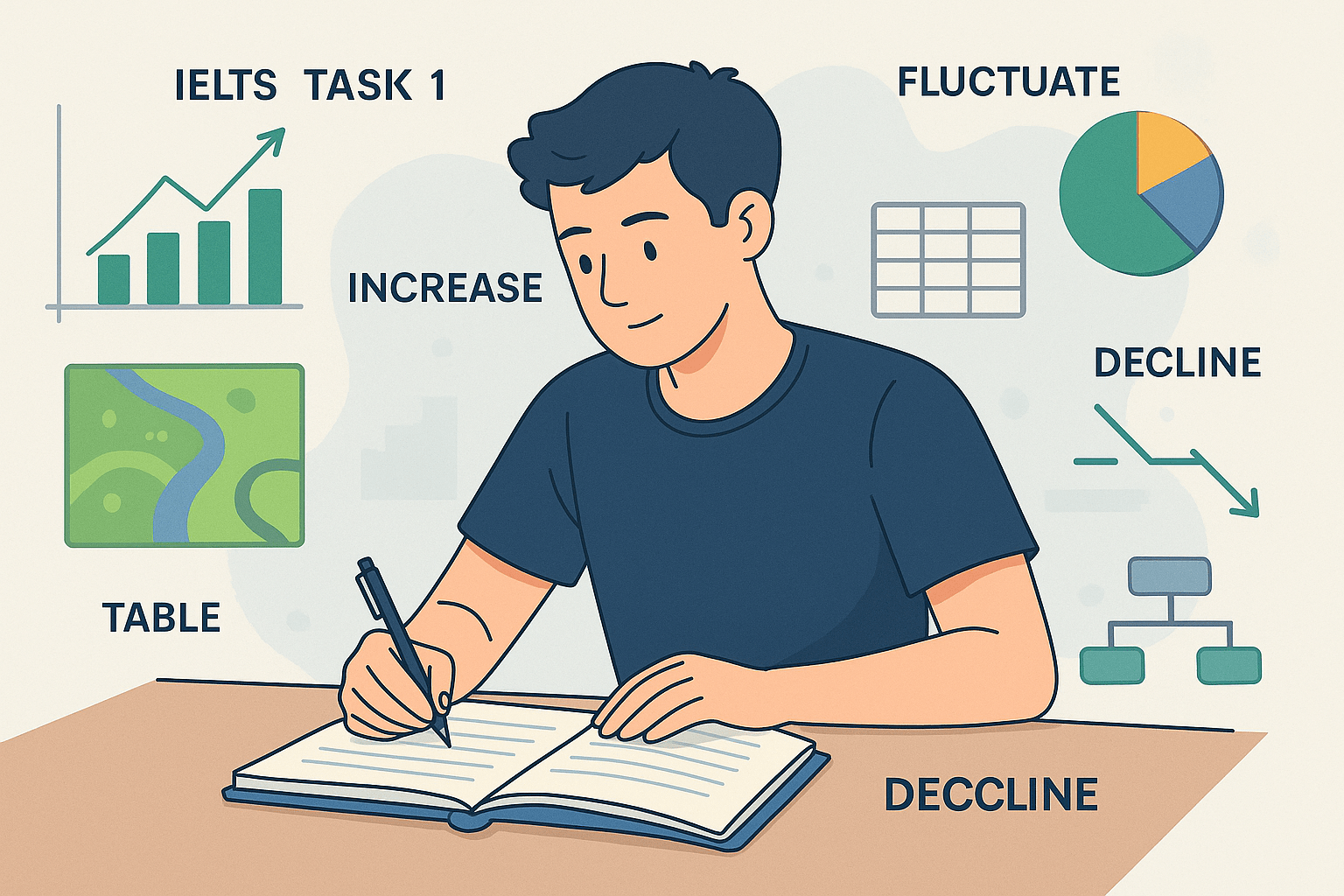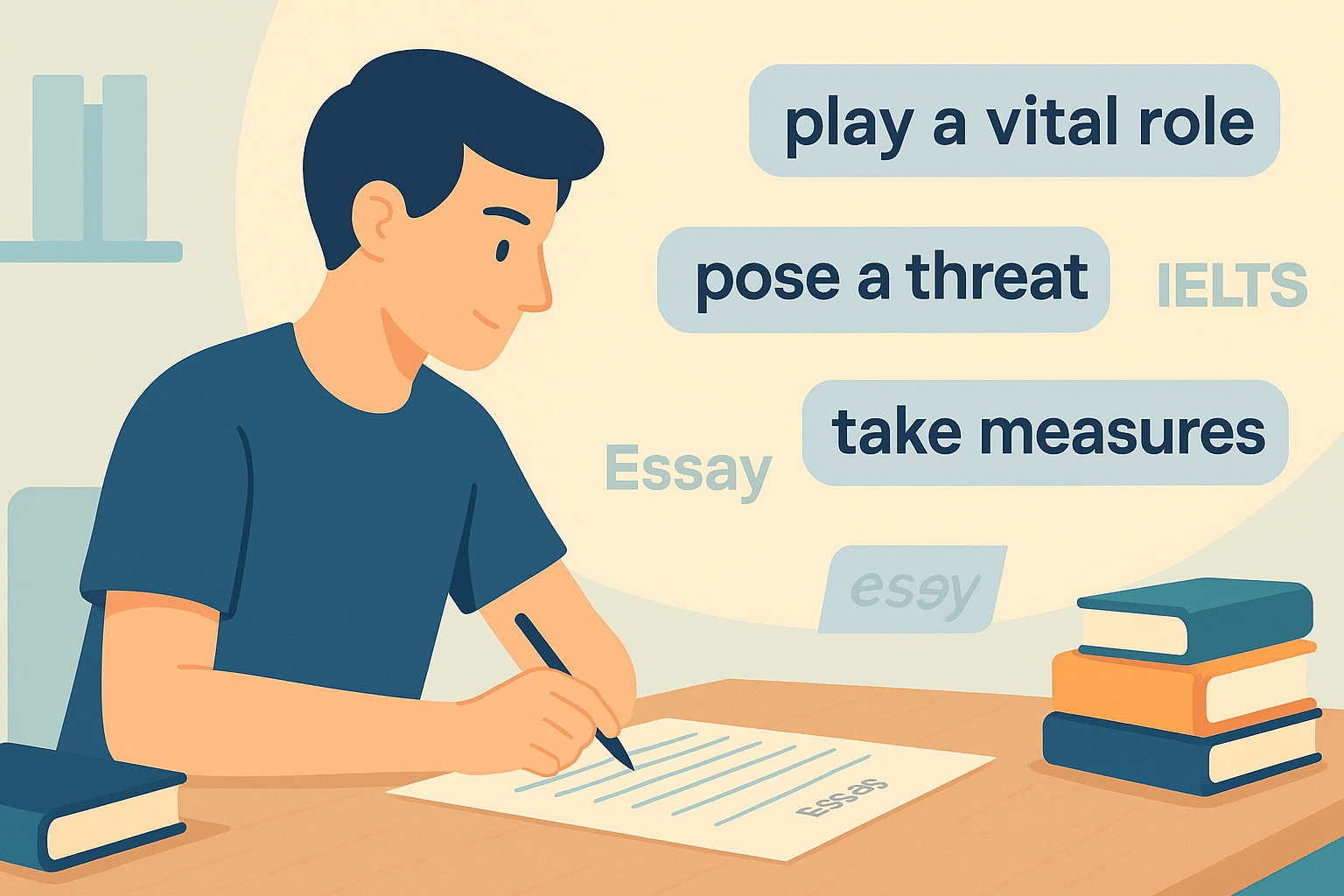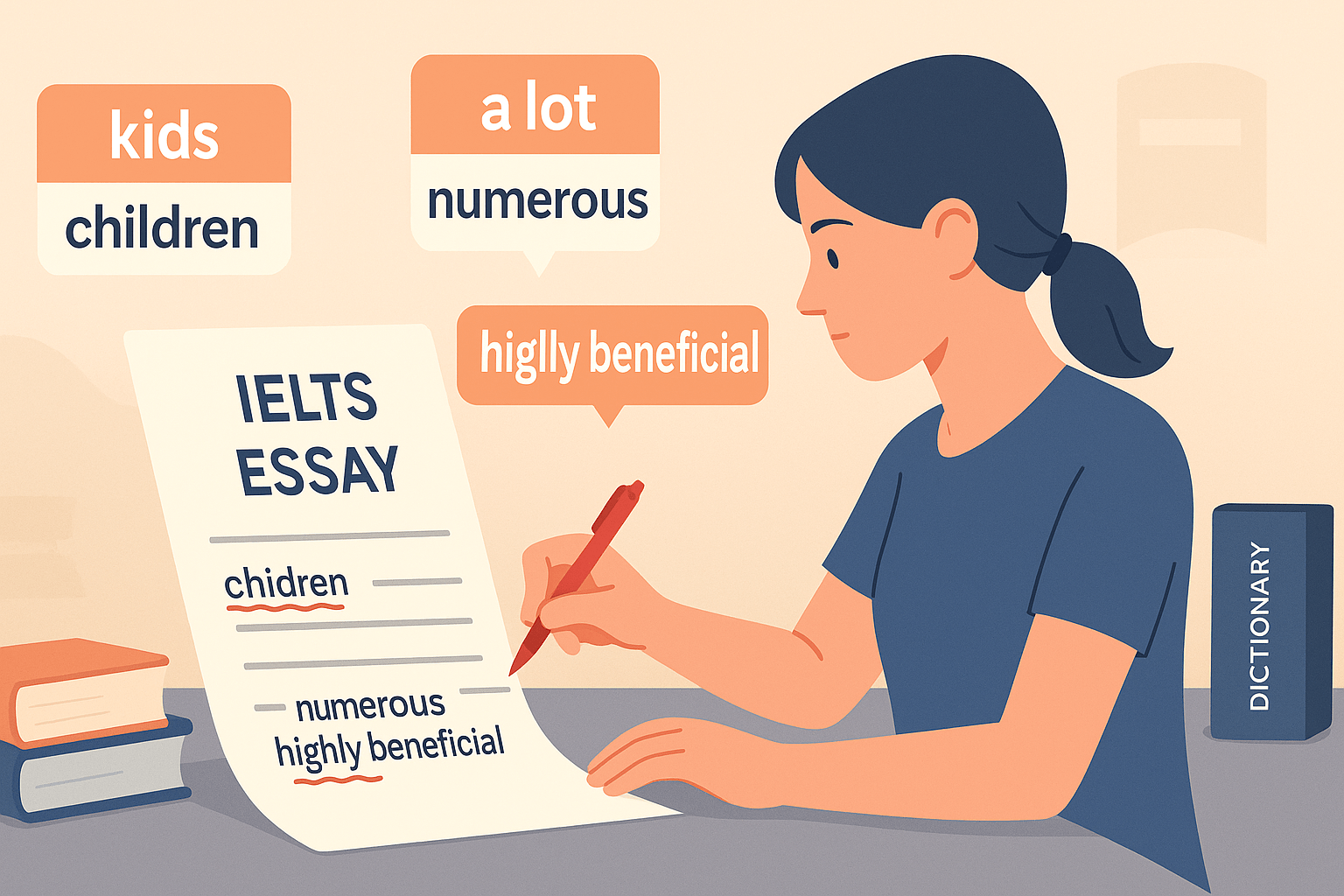When my students ask, “How do I get Band 7+ in IELTS Writing Task 1?” my answer always starts with one word: Vocabulary.
Your IELTS Writing Task 1 vocabulary determines whether your essay sounds academic and precise or simple and repetitive. Examiners score you on Lexical Resource, which makes up 25% of your Writing Task 1 band score.
To succeed, you need to:
- ✅ Describe trends, comparisons, and changes accurately
- ✅ Use formal and varied academic language
- ✅ Avoid repeating basic words like go up, go down, and big
In this complete guide, I’ll show you the essential IELTS Writing Task 1 vocabulary for line graphs, bar charts, pie charts, tables, maps, process diagrams, and mixed charts. I’ll also link to detailed guides for each chart type so you can master them one by one.
Before diving in, I recommend bookmarking the IELTS Writing Task 1 Vocabulary Complete Guide as your main resource for Task 1 vocabulary improvement.
Why IELTS Writing Task 1 Vocabulary Matters
Vocabulary is more than just words—it’s how examiners judge your ability to:
- ✅Describe data clearly without confusing the reader
- ✅ Show trends and comparisons using precise language
- ✅ Paraphrase the task prompt instead of copying it
- ✅ Demonstrate academic tone, which is essential for Band 7+
For official scoring details, check:
IELTS Writing Task 1 Vocabulary by Chart Type
Let’s explore vocabulary for each type of IELTS Writing Task 1 question and link to in-depth guides for practice.
1. Line Graph Vocabulary
Line graphs show trends over time, so you need words for increase, decrease, and fluctuation.
Key Words & Phrases:
- Rise, increase, grow, climb, surge
- Drop, decline, decrease, fall, plummet
- Fluctuate, remain steady, stabilize, peak, reach a low
Example:
“The number of online learners increased steadily from 2010 to 2020.”
📖 Full guide: IELTS Line Graph Vocabulary
2. Bar Chart Vocabulary
Bar charts focus on comparison. You need words that show highest, lowest, and differences between categories.
Key Words & Phrases:
- The highest, the lowest, slightly higher than, considerably lower
- Accounted for, represented, made up
- Showed a difference of, was twice as many as
Example:
“Sales in 2020 were twice as high as in 2015.”
📖 Full guide: IELTS Bar Chart Vocabulary
3. Pie Chart Vocabulary
Pie charts are all about proportions and percentages.
Key Words & Phrases:
- Accounted for, comprised, constituted
- Represented, made up
- Majority, minority, roughly half, a small fraction
Example:
“Renewable energy accounted for 40% of total energy consumption.”
📖 Full guide: IELTS Pie Chart Vocabulary
4. Table Vocabulary
Tables show data comparisons in text form, requiring precise numeric and descriptive vocabulary.
Key Words & Phrases:
- Significant increase/decrease
- Remained unchanged / remained stable
- Showed a difference of, was similar to, slightly higher than
Example:
“The population in City A remained stable at 1 million over the decade.”
📖 Full guide: IELTS Table Vocabulary
5. Map Vocabulary
Maps are about describing locations and changes over time.
Key Words & Phrases:
- Located in, situated on, adjacent to
- Replaced by, converted into, demolished, expanded
- North of, to the west of, in the center
Example:
“The park, located in the city center, was converted into a shopping mall by 2020.”
📖 Full guide: IELTS Map Vocabulary
6. Process Diagram Vocabulary
Processes require sequence and passive voice to explain steps clearly.
Key Words & Phrases:
- First, next, then, subsequently, finally
- Is heated, is collected, is processed, is transported
- Followed by, resulting in, leading to
Example:
“The raw materials are mixed and heated before being processed into final products.”
📖 Full guide: IELTS Process Diagram Vocabulary
7. Mixed Charts Vocabulary
Mixed charts combine two or more chart types, requiring flexibility in your vocabulary.
Strategy:
- Combine trend language (line graph) + comparison (bar/pie)
- Use transitions to move between chart descriptions
Example:
“While the line graph shows a steady rise in smartphone usage, the pie chart indicates that most users preferred streaming services.”
📖 Full guide: IELTS Mixed Charts Vocabulary
Common Mistakes in IELTS Writing Task 1 Vocabulary
Even good students lose marks because of these errors:
- Repeating simple words (go up, go down, very big)
- Using informal language (kids, stuff, a lot)
- Not paraphrasing task statements
- Forgetting variety in trend descriptions
Teacher Tip:
Keep a synonym bank for Task 1:
- Increase → rise, climb, grow, surge
- Decrease → fall, drop, decline, plummet
- Stay the same → remain steady, stabilize, level off
Sample Band 9 Sentence Using Vocabulary from Multiple Chart Types
“The proportion of students choosing online courses rose steadily from 2010 to 2020, accounting for 45% of total enrollment by the end of the period. Meanwhile, physical campus attendance declined gradually, and two older buildings were converted into digital learning centers.”
- ✅ Trend vocabulary (rose steadily, declined gradually)
- ✅ Percentage language (accounting for 45%)
- ✅ Map/process vocabulary (converted into)
FAQ Section
Q1: What is IELTS Writing Task 1 vocabulary?
It is the formal, academic language used to describe charts, graphs, tables, maps, and processes in Task 1 essays.
Q2: Can I use the same words multiple times in my essay?
You should avoid repetition. Use synonyms and varied expressions to show lexical range.
Q3: How do I improve my IELTS Writing Task 1 vocabulary quickly?
Learn chart-specific words, practice paraphrasing tasks, and review sample Band 9 sentences.
Conclusion
Mastering IELTS Writing Task 1 vocabulary is your key to Band 7–9.
When you:
- ✅ Use chart-specific words naturally
- ✅ Combine trend, comparison, and process vocabulary
- ✅ Avoid repetition and informal expressions
…your writing will sound academic, clear, and examiner-friendly.
🔗 Next step: Explore all 7 detailed guides linked in this post to master every chart type and secure your target band score.





9 Responses